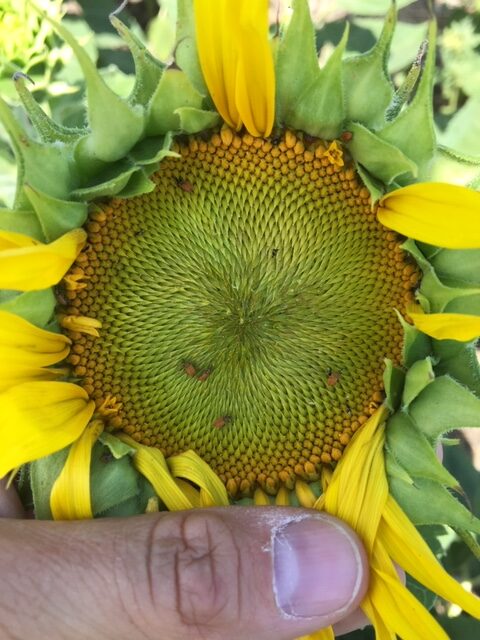With bloom time, also comes the potential for seed feeding insects and knowing how to protect your crop.
Banded Sunflower Moth – Alison Pokrzywinski | Nuseed Technical Agronomist

The banded sunflower moth is one of these insects of concern. The moth itself doesn’t do damage to the plant, but rather its larvae. When the larvae hatch they eat the seed and then exit, leaving behind a small hole. Typically, the moth will move into the sunflower field around the R3 stage and will lay their eggs on the back of the bracts.
Scouting can be done one of two ways. The first is by looking for eggs on the back of the bracts when the sunflowers are R3 to R4. The threshold for the number of eggs per bract varies based on the cost of treatment and market price. Right now an $18 sunflower crop with an $8 treatment with 20,000 plants per acre would need 3.2 eggs per 6 bracts to reach threshold.

The second is to monitor for the adults by walking into the field away from the margins and looking for the moths. They tend to rest on the leaves during the day and can often be seen when you walk through a field. An $18 sunflower crop at 20,000 plants per acre have a threshold of less than one moth per 100 plants. To help monitor the adults, there are traps available that get placed within a field.

When putting together a monitoring trap remember to wear gloves when placing the pheromone so the human scent doesn’t get on it. Also, use a fiberglass pole or a piece of wood to attach it to in the field away from the margins.
Optimal time to spray with an insecticide is at R5.1 (early bloom) and most labeled insecticides are very effective. If you have a confection field, consider spraying twice.
NDSU has some great resources out there with videos for egg scouting and tables showing Economic Injury Levels so a grower knows when they should spray.
Seed Weevil Woes – Dr. Janet Knodel – NDSU Entomologist


Feeding damage caused by red sunflower seed weevil larvae can cause big problems for producers. Throughout July and August, adult seed weevils emerge from the soil and feed on sunflower foliage and buds, they then move to the heads to feed on pollen and flowers.
Female seed weevils deposit eggs right in the seeds. Larvae feed on the kernels in August and September, and in the fall they chew a hole in the side of the kernel and drop down to the ground to overwinter in the soil.
“The red sunflower seed weevils feed on seeds and reduce the size of seeds. Sometimes when you combine, the seeds will get blown out the back. They also reduce sunflower yield and oil quality,” says Knodel. To manage the seed weevils they must be prevented from laying eggs. “Once they’re in the seed, that larva is protected, and it will feed on the kernel,” says Knodel.
Scouting is essential for seed weevil management. Knodel recommends scouting early because weevils are attracted to the earliest blooming fields where they will start to congregate. Crop protection products should only be applied when economic thresholds are reached. Farmers must calculate accurate economic thresholds for their fields using correct sampling methods before applying insecticide for seed weevil control.
Currently, an infestation level of one to two red sunflower seed weevils per head in confection and four to six per head in oil sunflowers are the average economic thresholds. The best window for insecticide spray timing is when 50 percent of the plants in a field have developed yellow ray petals (R5.0), 30 percent of the plants are shedding pollen (R5.3) and 20 percent of the plants are at the bud stage (R2 to R3).
There are a number of foliar insecticides registered to control red sunflower seed weevil, including organophosphates and pyrethroids. However, some of those insecticides are currently under regulatory review.
Cultural management strategies include planting early, which will help reduce the number of seeds infested in the field. However, producers must be mindful of other pests in their fields. For example, planting early may help reduce seed weevil infestation, but producers may run into banded sunflower moth issues. Trap cropping can also be effective; however, producers must plant twice – sunflowers are planted early (seven to 10 days) around the field’s perimeter before seeding the main field.
